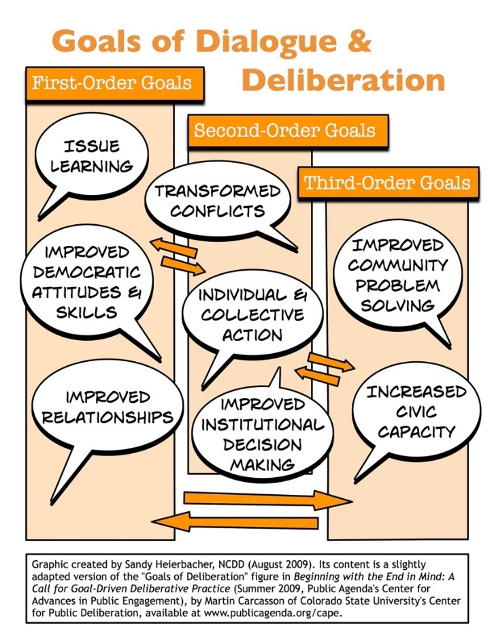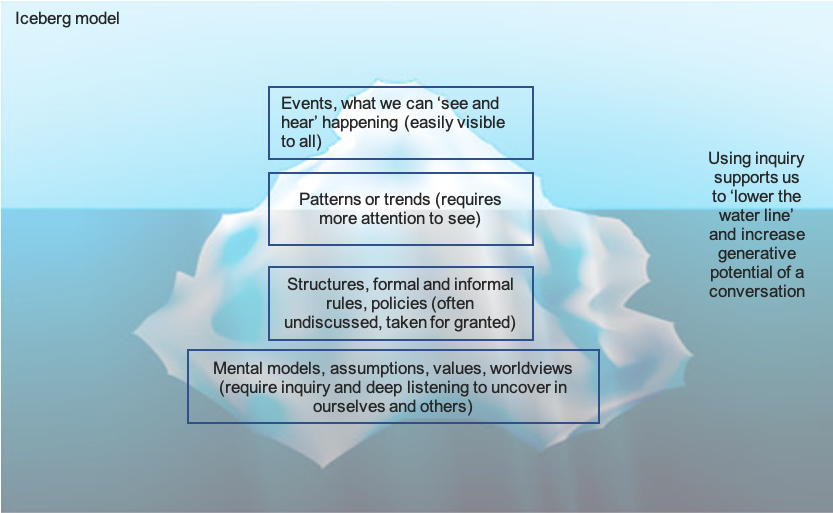Dialogue: Foundational Assumptions
Dialogue is a term that can carry a broad range of meanings and be used in many varied contexts. It is both a formally defined practice and a general orientation towards group dynamics, meeting facilitation, hosting, and community engagement (Heierbacher, 2010). Dialogue can be thought of as an orientation, a key set of assumptions or even a worldview that shapes how we engage with and convene others, from one-on-one casual conversations, to multi-partner structured processes.
The Goals of Dialogue and Deliberation (NCDD, 2010) illustrated in the graphic below, provide a perspective on the benefits or ‘why’ of dialogue-based approaches.
Source: The National Coalition for Dialogue & Deliberation. (2010). https://ncdd.org/rc/wp-content/uploads/2010/08/Goals_Comic_fullpage.jpg )
Whether referring to an informal meeting, or a more structured and lengthy process, practices that might be categorized as ‘dialogue’ arise from some of the following assumptions:
A Holistic Worldview
A holistic worldview recognizes not only the imperative to incorporate multiple parts or perspectives from the wider system into a process, but also the inseparability of the parts of that system. In practice this means that conversation is focused not on advancing one perspective at the expense of others, or on simply implementing the ‘majority’ view. Instead, it focuses on making space to hear the inherent wisdom of multiple perspectives so that the group can work together to generate outcomes that emerge from the interaction among those views. Such outcomes would not have been possible with individual points of view advanced in competition with one another.
As Isaacs (1999) writes, “Complex issues require intelligence beyond that of any individual.” Even as the dominant and habitual ways of thinking, working and meeting with one another “tend to… lead us away from wholeness and into fragmentation” (p. 108).
Trust in the Group
These methods rely on an assumption that, under well facilitated and convened conditions, diverse groups of individuals can come together to create something they couldn’t create on their own. As Schein (1993) writes, “In this process, we do not strive to convince each other, but instead try to build a common experience base that allows us to learn collectively. The more the group achieves such collective understanding, the easier it becomes to reach a decision, and the more likely it is that the decision will be implemented in the way the group meant it to be” (p. 43).
Through this approach, write Brown and Isaacs (n.d.), “people discover who cares about what and who will be accountable for next steps. We are finding that when people come to a new level of shared understanding around real-life issues, they want to make a difference.”
There are at least two critical ways in which this approach differs from meetings that are more common in the dominant culture of institutions and organizations:
Emphasis on Relationship Building
The first is in the amount of time and space given to building relationships among participants in a conversation. While this can seem like nothing is being ‘accomplished’ it is the work of weaving connection that creates the container in which a group can develop the trust and safety to explore critical differences, release the security of their own positions and create more generative solutions together.
Conflict as a Source of Wisdom
The second element of this approach treats difference or conflicting views in the group, not as something to be avoided, but something to inquire into, with the view that there is wisdom in the tensions and that “no one has monopoly on the truth” (Lewis Deep Democracy, slide 66). The iceberg image offers a helpful metaphor for this assumption.
More detail about how to implement these approaches is described in the methods and tools section that follows.



